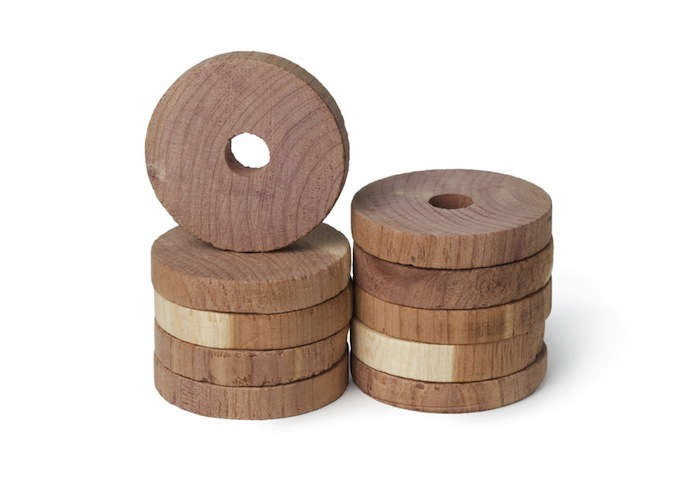
Plenty of spring cleaning chores are optional, but if you care about your clothes, now is the time to be on guard against moths. Why now? Because it’s actually the moth larvae (and not the moths themselves) that do the damage, and “they hide out in dark, humid places, so spring and summer is when they thrive,” says Kellen Tucker. Kellen needs to know these things: She’s the owner of Sharktooth in Brooklyn, one of our favorite sources for vintage blankets and rugs.
The textile specialist recently filled us in on How to Clean Woolen Blankets before putting them away for the season. We asked her to tell us how she maintains her “carefully guarded moth-free ecosystems” at home and in her Williamsburg shop. The good news: She uses only natural deterrents, many of them sweetly scented, and often mixes her own potions. Here are her five lines of defense, DIY details included. What do you swear by? Go to the Comments section to fill us in.

1. Clean Up
Keeping everything clean is essential. That’s because moth larvae—half-inch-long hungry caterpillars—don’t like clean fabrics; they feed on natural fibers only, and are especially attracted to dirty wool and silk. So regularly shake out your wool blankets and also vacuum your clothes and linen closets.
2. Create a DIY Cedar Closet
It’s crucial to deploy some ingredients that moths don’t like, but avoid moth balls—they’re as poisonous as they smell. Happily, so many scents pleasant to us are repulsive to moths. At Sharktooth, we keep blocks and rounds of cedar wood in closets and on shelves. As the aroma fades, the wood becomes less effective, so we refresh our blocks every few months by sanding and rotating them. Cedar oil is the only natural thing that kills moth eggs; the rest is merely preventative, but helpful nonetheless.

3. Deploy Potent Sachets
At the Union Square Farmers’ Market, in New York City, we buy bags of Loose Dried French Lavender (eight ounces for $15) from Lavender by the Bay, a farm on the North Fork of Long Island, and disperse spoonfuls into muslin pouches (they start at 25 cents each at Paper Mart). The lavender can be mixed with other dried ingredients known to ward off moths, such as bay leaves, lemon balm, peppermint, and cedar shavings.
We scatter the sachets in the folds of blankets and the hollow of rolled rugs. The scent is what deters moths, and the great thing about lavender in particular is that it lasts a long time: All you have to do is squeeze it and it’s fresh again. A few recommended sources for dried bulk herbs and spices: Dual Spices and Sahadi’s, both in NYC, and Mountain Rose Herbs.
In addition to sachets, I hang Diptyque’s Baies Scented Ovals in my closets and wherever I store woolens. They’re medallions of perfumed wax with a berry scent, and they’re pricey—$48 each—but I’m a devotee; I have blankets that still smell softly of the ovals a year later.

4. Set Traps
Pheromone traps are another staple in my life. They work by luring male moths, who then get stuck to the glue, decreasing chances for mating and hence the number of eggs and larvae. These cardboard tents are safe and odorless; they can be perched on shelves or hung—and you forget they’re there until it occurs to you to check, or, worse, you notice some trapped prey. They’re what you need to monitor your moth situation.

5. Spritz Fragrant Water
Anything that smells clean or floral is unattractive to moths. At Sharktooth, we take a note from the Shakers and use rosewater. It works subtly on its own and more powerfully blended with essential oils. Here’s a super-simple recipe for making your own intoxicating spray (next, like me, you’ll be blending your own perfume).
DIY Fragrant Water
- 16 ounce spray bottle
- 1/2-1 Tablespoon essential oil* (experiment with you own mix using scents you like; my favorite source is Enfleurage)
- 1/2 ounce distilled alcohol (optional, to help water and oil mix; vodka also works)
- Distilled water, or a mix of distilled water and rosewater to fill bottle
*Recommended Moth-Deterring Essential Oils:
Base notes: cedarwood, clove, vetiver, sandalwood
Middle notes: sage, rosemary, orange blossom, geranium, lemongrass, lavender
Top notes: bergamot, grapefruit, peppermint, eucalyptus
Give your concoction a good shake and spray near wool and other fabrics—two to three feet away is good. The deeper balsamic and higher acidic scents hang out in the air much longer than floral ones, so use sparingly. Your house will be subtly perfumed—and moth free.

Let the spring cleanup continue. Here are a few more of our Domestic Science tips:
- Easy DIY: Homemade Dish Soap (another good use for essential oils)
- 10 Ways to Use Vinegar in the Home
- The Tidy Life: 7 Daily Habits from the Author of “Simple Matters”






Have a Question or Comment About This Post?